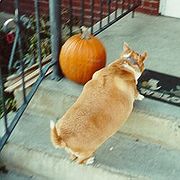
Dog Obesity
Veterinarian Reviewed on June 17, 2012 by Dr. Janice Huntingford
Dog Obesity
Signs and Symptoms
Along with the ever-increasing girth of the people in America, America’s pet dogs, too, are becoming increasingly obese. Over the past 20 years, it’s been documented that obesity is on the rise in Americans, so much so that in fact, today’s President is paying attention and implementing public school gym programs to address the problem for our children. However, pets are not getting the same focus, even though they’re in just as much trouble as their human families are.
More sedentary, less activity
It’s no surprise that people are more obese than they were previously. In days gone by, you didn’t “exercise” as a separate pastime. Instead, it was built into your daily life. Physical activity was the norm, and high exertion physical activity like chopping wood, hunting, doing laundry and other high labor-intensive housework by hand was part of daily life. Today, however, our lives have become increasingly sedentary, such that most of us work at desk jobs.
Add to that easy access to high calorie, low to no nutrition foods, and you can see how it’s easy to pack on the extra weight. More than that, though, because exercise is no longer built into our daily lives as a matter of course, we have to make time to do it – and we don’t.
It’s the same for our pets. Pets today, too, lead much more sedentary lives than they did in years past, and easy access to commercial dog food with little to no portion control by “also fat” owners only increases the problems.
However, like their owners, dogs can experience the same health problems as humans can. Conditions like Dog Diabetes mellitus, Dog Arthritis, and excess stress on organs like the heart, lungs, kidneys, joints and liver are also very common. This leads to a shortened lifespan and a lower quality of life for dogs, just as it does for their owners who suffer from similar health problems.
How can you tell if your dog is overweight?
If you’re taking your dog in for regular checkups, chances are your vet has already commented on the fact that your dog is overweight. Just how you tell may differ based upon your dog’s breed, of course, but in general, if you can feel but not see your dog’s ribs, and he has a definite narrowing of a “waist,” is a good size. If you pet your dog and you can’t feel his ribs, chances are he’s overweight. If his bones obviously protrude, especially at the hipbone, he’s too thin.
Helping your dog lose weight
What can you as an owner do to help your overweight to obese dog lose weight and therefore be healthier and happier?
Here are some things to keep in mind:
• Feed a Dog Food that is both healthy and nutritious food – and exercise portion control
Dogs will eat what you give them, and happily so. However, they don’t have significant control over their appetites, because in the wild, when they hunt, they eat as much as they can so as to survive until the next meal. That’s not necessary in modern society, of course, but a dog will still usually eat as much as he can, based upon his survival instincts. So feed your dog a healthy food and exercise portion control at the same time; follow directions on the food’s label, and/or follow your vet’s directions to determine what portion sizes are best for your dog.
• Make sure your dog exercises
Dogs need exercise just like humans do. So take your dog for walks, play ball or Frisbee in the yard, play catch, and simply up your dog’s physical activity as much as you can, as his health allows. It’s a good idea to take your dog in for a physical to make sure he can handle physical exertion; your vet, again, can give you tips on how to exercise your dog safely, so that he’ll lose weight safely as well.
Sign up for our newsletter and receive more articles and the latest pet health updates and special offers.
Our Expert
 Dr. Janice Huntingford
Dr. Janice HuntingfordJanice Huntingford, DVM, has been in veterinary practice for over 30 years and has founded two veterinary clinics since receiving her Doctor of Veterinary Medicine at the Ontario Veterinary College, University of Guelph. She has studied extensively in both conventional and holistic modalities. Ask Dr. Jan

